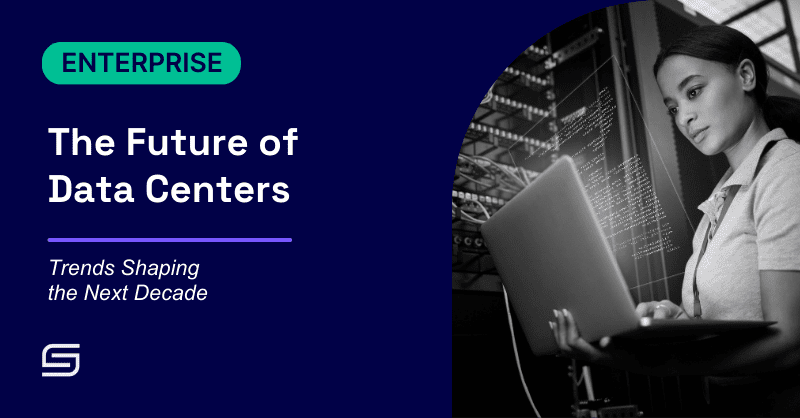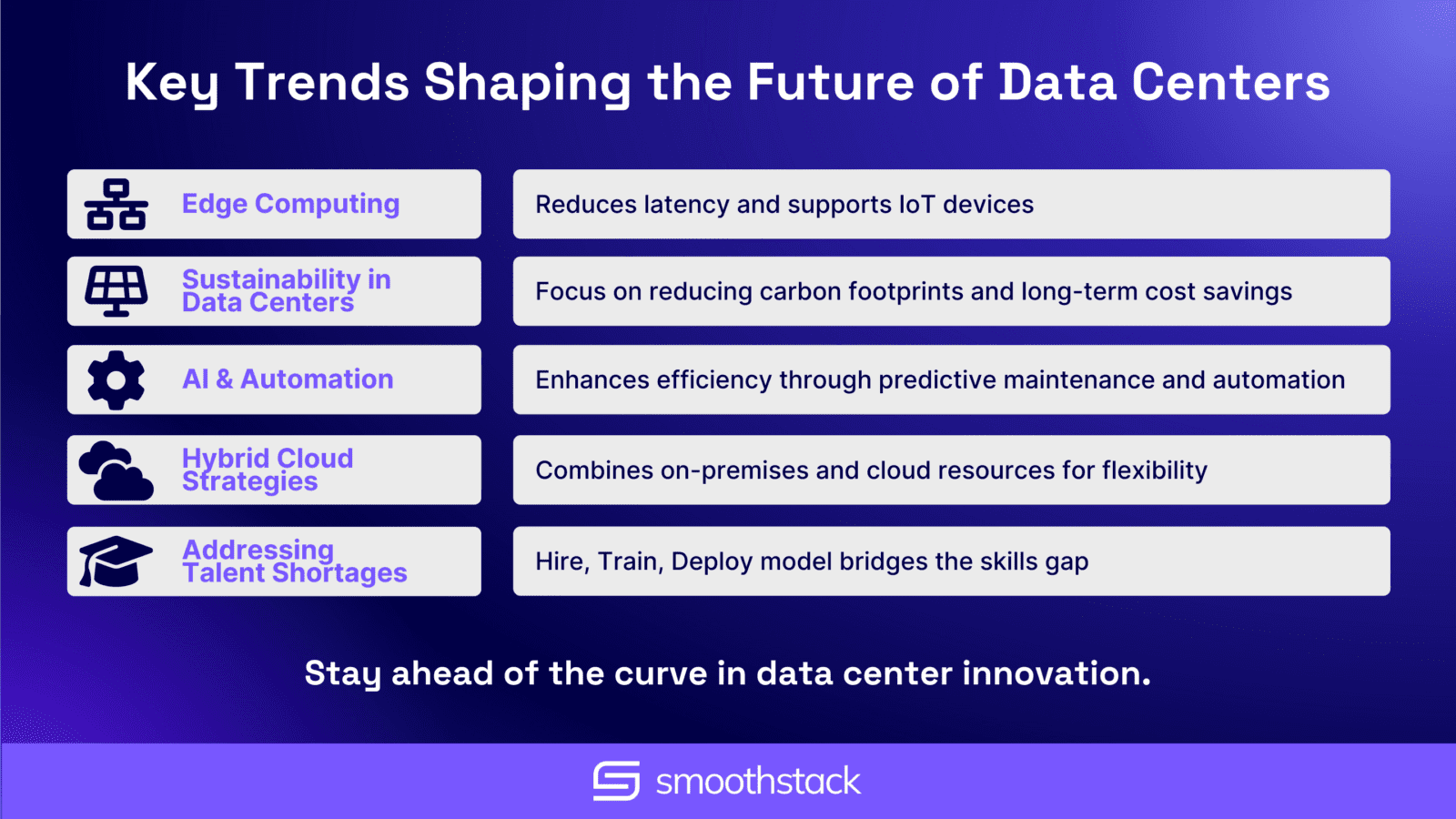The Future of Data Centers: Trends Shaping the Next Decade

As the digital economy expands, data centers are crucial for managing vast amounts of data. The next decade promises significant changes, driven by advancements in technology, a focus on sustainability, and the challenge of addressing talent shortages. Understanding these trends is essential for data center managers and business leaders who want to stay ahead.
Edge Computing: Decentralizing Data Centers
Edge computing is transforming data centers by moving data processing closer to the source. This reduces latency and supports the growing number of IoT devices requiring real-time analysis. Organizations are adopting hybrid models that combine traditional data centers with edge locations, enhancing data management and customer experiences. This approach is particularly vital for industries like healthcare, finance, and telecommunications, where speed and reliability are paramount.
The push towards edge computing also offers significant benefits for reducing network congestion. By processing data closer to the source, companies can minimize the amount of data that needs to travel back to centralized data centers, improving efficiency and reducing costs. This is especially important in sectors that handle vast amounts of data daily, such as video streaming services, autonomous vehicles, and smart city infrastructure. As more devices and services become interconnected, the demand for real-time data processing will only grow, making edge computing an increasingly critical component of modern data center strategies.
To thrive in this new environment, companies must rethink their data center strategies, invest in new infrastructure, and develop expertise in managing distributed systems. Those who adapt quickly will be well-positioned to leverage real-time data processing and capitalize on the enhanced capabilities it offers. For more insights, check out Smoothstack’s post on Smoothstack’s post on The End of One-Size-Fits-All Technology Talent is Here.

Sustainability: Green is the Future
As environmental concerns grow, the demand for sustainable data centers is increasing. Companies are under pressure to reduce carbon footprints and adopt greener practices like renewable energy sources, optimized cooling systems, and energy-efficient hardware. These green data centers not only benefit the environment but also offer long-term cost savings by reducing energy consumption.
The adoption of sustainability measures also aligns with broader corporate social responsibility (CSR) goals. Data center operators are increasingly expected to demonstrate their commitment to environmental stewardship, and those that succeed will likely gain a competitive edge. For instance, companies that utilize renewable energy sources or employ advanced cooling technologies can reduce their operational costs and attract customers and partners who prioritize environmental sustainability. In some regions, regulatory requirements are also becoming stricter, making it essential for data centers to adopt green practices to remain compliant and avoid potential fines.
Prioritizing sustainability is no longer optional—it’s a business imperative. Companies that adopt these practices will meet regulatory requirements, enhance brand reputation, and attract environmentally conscious customers. Explore how industries are adapting in our blog on The Semiconductor Boom Is Here and You’re Already Behind.
AI and Automation: Transforming Operations
Artificial intelligence (AI) is revolutionizing the tech landscape, and data centers are at the forefront of this change. AI is not just optimizing data center operations; it’s fundamentally altering how businesses approach data management, security, and infrastructure. By enabling predictive maintenance, AI reduces downtime and improves efficiency. Intelligent cooling systems powered by AI adapt in real-time to fluctuations in workload, drastically lowering energy consumption and operational costs.
AI’s role in cybersecurity is another critical area of impact. With the increasing complexity and frequency of cyber threats, AI-driven systems can identify vulnerabilities, detect unusual activity, and respond to potential breaches faster than traditional methods. This level of protection is crucial for data centers that manage sensitive information, as a single security breach can have far-reaching consequences, including financial losses and reputational damage.
Moreover, AI-powered analytics allow organizations to extract actionable insights from massive datasets, enhancing decision-making processes across the board. AI can help optimize things like:
- Resource allocation
- Predicting future trends
- Personalize customer experiences
These contributions lead to improved operational efficiency and provide a competitive advantage.
As AI continues to advance, its integration into data center operations will become even more critical. Organizations that harness the power of AI will reduce costs, improve service delivery, and stay ahead of technological disruptions. Embracing AI is not just about keeping up with trends—it’s about leading the charge into the future of technology.
Talent Shortage: Bridging the Skills Gap in Data Centers
The data center industry is facing a significant talent shortage, particularly in areas like network management, cybersecurity, and cloud computing. As data centers grow more complex, the demand for qualified professionals continues to rise, but the industry struggles to find and retain the necessary talent.
One solution to this challenge is the Hire, Train, Deploy (HTD) model, which plays a crucial role in workforce development. HTD involves hiring candidates with potential, providing specialized training, and then deploying them to fill critical roles. This approach not only bridges the skills gap but also ensures a steady pipeline of skilled professionals.
In addition to HTD, companies can explore IT staffing provider partnerships with educational institutions to develop tailored training programs that align with industry needs. These partnerships can help create a future-ready workforce equipped with the skills required to manage the next generation of data center technologies. Moreover, offering internships and apprenticeships can provide hands-on experience to emerging talent, fostering a new generation of data center professionals.
Organizations can also upskill their current employees to fill more advanced roles within the company. By investing in continuous learning and development, companies can retain top talent and reduce the impact of the talent shortage. Leveraging talent solutions like Smoothstack’s can further ensure that businesses thrive in this competitive landscape.
For more on this topic, check out our posts on Revolutionizing Talent Acquisition in the Semiconductor Industry and Bridging the Digital Skills Gap.
The future of data centers is shaped by advancements in technology, a growing focus on sustainability, and the need to address talent shortages. Data center managers and business leaders who embrace edge computing, adopt green practices, leverage AI, and invest in talent development will be better equipped to navigate the challenges and opportunities of the next decade.
By staying informed and proactive, your organization can ensure its data center strategy is future-proof and aligned with industry advancements.
Have questions? Contact Smoothstack, one of the best technologies staffing companies leveraging Hire Train Deploy.
Let’s Build Your Team
Connect with the Smoothstack team to learn how to close your digital skills gap with a custom-trained team.
